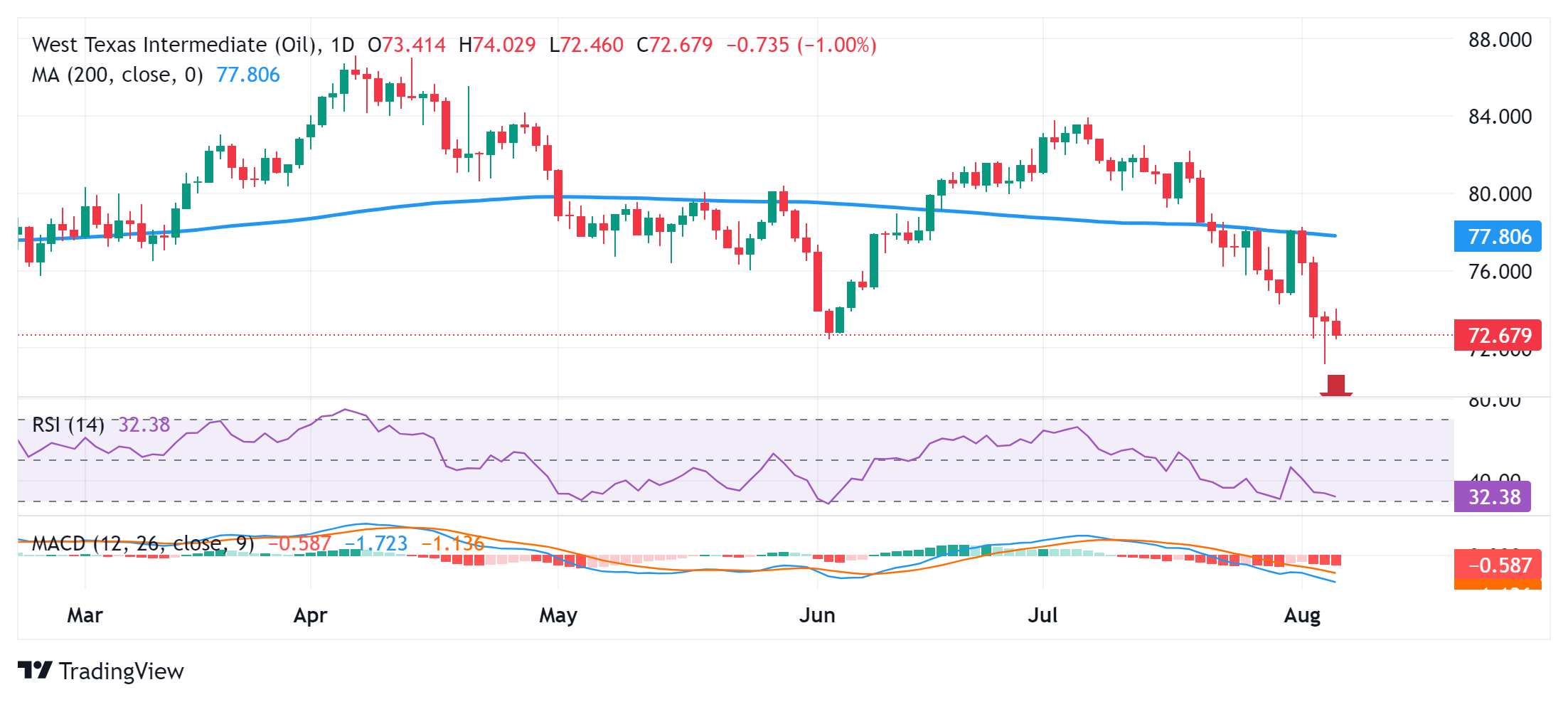- WTI fell for the fourth consecutive day on Tuesday.
- Demand concerns weigh on the commodity amid notable USD demand.
- The Middle East crisis could help limit crude oil losses.
US West Texas Intermediate (WTI) crude oil prices attracted fresh sellers after an intraday rally to the $74.00/barrel mark and fell for the fourth consecutive day on Tuesday. The commodity traded around the mid-$72.00 zone during the early part of the European session, although it managed to hold above its lowest level since January 17 hit on Monday.
Concerns over an economic slowdown in the US and China, the world’s two largest economies, continue to act as a headwind for crude oil prices. Adding to this is the emergence of some US Dollar (USD) buying, driven by a spike in US Treasury bond yields, putting additional pressure on the USD-denominated commodity. That said, concerns over supply disruptions from the Middle East, amid the risk of a wider conflict in the key oil-producing region, could help limit crude’s losses.
From a technical perspective, the recent downside break and repeated failures near the all-important 200-day simple moving average (SMA) favor the bears. Moreover, oscillators on the daily chart have been gaining negative traction and are still far from being in oversold territory. This, in turn, suggests that the path of least resistance for crude oil prices is to the downside and supports prospects for an extension of the downward trajectory seen over the past month or so.
Meanwhile, the round figure of $72.00 is likely to protect the immediate downside ahead of the overnight intraday low around $71.20-$71.15 region. Some follow-through selling below the $71.00 mark will reaffirm the negative bias and make crude oil prices vulnerable to accelerate the decline towards the intermediate support near the mid-$70.00 zone en route towards the psychological $70.00 mark. The depreciating move could further extend towards the next relevant support near the $69.60-$69.50 horizontal zone.
On the upside, any meaningful recovery attempt now seems to face stiff resistance near the intraday high, around the $74.00 mark. Sustained strength beyond it could trigger a short-covering rally and lift crude oil prices towards the $74.90-$75.00 region. The recovery momentum could further extend towards the next relevant hurdle near the $75.60 zone en route towards the $76.00 mark. The latter should act as a key pivot point for short-term traders and cap any further upside for the commodity.
WTI daily chart
WTI Oil FAQs
WTI crude oil is a type of crude oil sold on international markets. WTI stands for West Texas Intermediate, one of three main types that include Brent and Dubai crude. WTI is also known as “light” and “sweet” for its relatively low gravity and sulfur content, respectively. It is considered a high-quality oil that is easily refined. It is sourced in the United States and distributed through the Cushing hub, considered “the pipeline crossroads of the world.” It is a benchmark for the oil market and the price of WTI is frequently quoted in the media.
Like all assets, supply and demand are the main factors determining the price of WTI crude oil. As such, global growth can be a driver of increased demand and vice versa in the case of weak global growth. Political instability, wars and sanctions can disrupt supply and impact prices. Decisions by OPEC, a group of large oil producing countries, are another key driver of price. The value of the US Dollar influences the price of WTI crude oil, as oil is primarily traded in US Dollars, so a weaker Dollar can make oil more affordable and vice versa.
The weekly oil inventory reports published by the American Petroleum Institute (API) and the Energy Information Agency (EIA) influence the price of WTI oil. Changes in inventories reflect fluctuations in supply and demand. If the data show a decrease in inventories, it may indicate an increase in demand, which would push up the price of oil. An increase in inventories may reflect an increase in supply, which pushes down prices. The API report is published every Tuesday, and the EIA report the following day. Their results are usually similar, with a difference of 1% between them 75% of the time. The EIA data is considered more reliable because it is a government agency.
OPEC (Organization of the Petroleum Exporting Countries) is a group of 13 oil-producing nations that collectively decide on member countries’ production quotas at biennial meetings. Their decisions often influence WTI oil prices. When OPEC decides to reduce quotas, it can restrict supply and drive up oil prices. When OPEC increases production, the opposite effect occurs. OPEC+ is an expanded group that includes ten other non-OPEC countries, most notably Russia.
Source: Fx Street
I am Joshua Winder, a senior-level journalist and editor at World Stock Market. I specialize in covering news related to the stock market and economic trends. With more than 8 years of experience in this field, I have become an expert in financial reporting.








